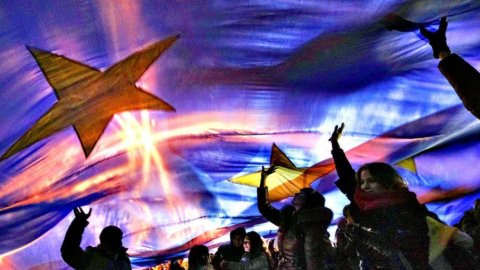The last major French exhibition of this artist's work was held in 1996 at the Pompidou Center. More than twenty years later, Bacon: Books and Painting it presents paintings dating from 1971, the year of the retrospective event in the national galleries of the grande palais, to his final works in 1992. Didier Ottinger is the curator of this innovative exploration of the influence of literature on Francis Bacon's painting.
The exhibition comprises six rooms along the gallery, placing literature at the center of the exhibition. These rooms reproduce readings of excerpts from Francis Bacon's library by Mathieu Amalric, Jean-Marc barr, Carlo Brandt, Valérie Dreville, hippolyte Girardot, Dominique Reymond and andré Wilms. Not only did these authors directly inspire Bacon's work and motifs, they also shared a poetic world, forming a “spiritual family” with which the artist identified. Every writer expressed a form of "atheology," a distrust of any value (abstract beauty, historical teleology or divinity, etc.) that could dictate the shape and meaning of ways of thinking or of a work of art. From Nietzsche's struggle against the "backworlds" to Bataille's "basic materialism", Eliot's fragmentation, Aeschylus' tragedy, Conrad's "regressionism" and "sacred" lairs, these authors shared the same amoral and realist vision of the world, a concept of art and its forms liberated from idealism. The inventory of Francis Bacon's library, compiled by the Department of History of Art and Architecture at Trinity College Dublin, lists more than a thousand works. While denying any "narrative" exegesis in his work Francis Bacon nevertheless admitted that literature was a powerful stimulus to his imagination. Rather than shaping a story, poetry, novels, and philosophy inspired a "general mood"; “Images” that emerged like the Furies in his paintings. Bacon confided to David Sylvester his interest in the works of Eliot or Aeschylus, which he claimed
“know by heart,” adding that he has only ever read texts that evoke “immediate images” for him. These images owed more to the world of poetry, existential philosophy or the form of literature he had chosen than to the stories they told.
Three Studies for Figures underlie a crucifixion, dating from 1944, testify to the impact of Aeschylus' tragedy on his work.
The exhibition at the Pompidou Center focuses on works produced by Bacon in the last two decades of his career. It consists of sixty paintings (including 12 triptychs, as well as a series of portraits and self-portraits) from the main private and public collections. From 1971 to 1992 (the year of the artist's death), his painting style was characterized by its simplification and intensification. his colors acquired new depth, drawn from a single chromatic register of yellow, pink and saturated orange.
1971 was a turning point with the exhibition at the Grand Palais where it won him international acclaim, while the tragic death of his partner just days before the exhibition opened gave way to a period marked by guilt and represented by a proliferation of the symbolic and mythological form of the erinyes (Furies of Greek mythology) in his work. The “black” triptychs painted in memory of his deceased friend (In memory of George Dyer, 1971, triptych – August 1972 and triptych, May-June 1973), all presented in the exhibition, commemorate this loss.





